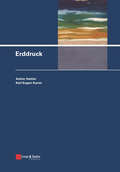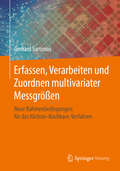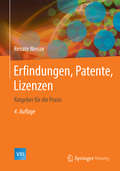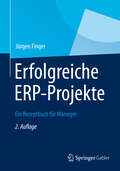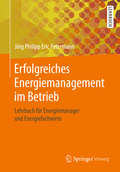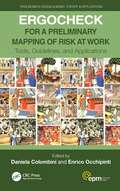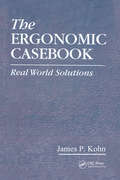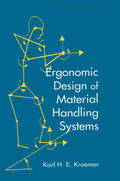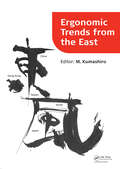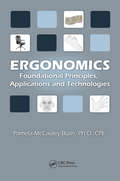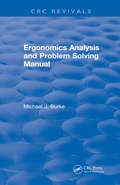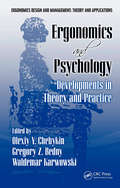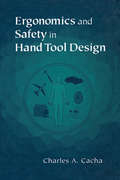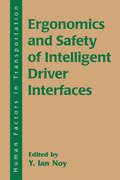- Table View
- List View
Erddruck
by Achim Hettler Karl-Eugen KurrerDas Thema Erddruck gehört zu den ältesten und umfangreichsten Kapiteln der Bodenmechanik und des Grundbaus und ist eine der Säulen des konstruktiven Ingenieurbaus. Eingangs wird die Entwicklung der Erddrucktheorie ausführlich beschrieben. Die Darstellungen reichen von den ersten Ansätzen der Erddruckbestimmung über kontinuumsmechanische Erddruckmodelle bis zur Integration der Erddruckforschung in das disziplinäre Gefüge der Geotechnik. Der Hauptteil des Buches umfasst eine Auswahl aktueller Berechnungsgrundlagen. Ziel ist es, den Grundbauingenieuren und den Tragwerksplanern in Baufirmen, Ingenieurbüros sowie in der Bauverwaltung aber auch Studenten eine Sammlung von Arbeitsanleitungen zur Verfügung zu stellen. Um das theoretische Verständnis zu wecken, werden zunächst die wesentlichen Grundlagen zur Ermittlung des Erddrucks vorgestellt. Anschließend werden die für die Praxis wichtigsten Verfahren zum aktiven und passiven Erddruck sowie zum Erdruhedruck behandelt. Dabei werden auch räumliche Wirkungen berücksichtigt. Ein Anliegen ist es, in knapper Form auch Hinweise zu nicht alltäglichen Fragestellungen zu geben und auf weiterführende Literatur zu verweisen. In den letzten Jahren ist immer mehr die Verschiebungsabhängigkeit des Erddrucks in den Blickpunkt getreten. Dies betrifft nicht nur den passiven, sondern auch den aktiven Fall. An den DIN-Ausschuss "Berechnungsverfahren" wurden immer wieder Fragen herangetragen. Eine Auswahl davon wird im Kommentar zu DIN 4085 behandelt, der auch Hinweise zu den Beispielen im Beiblatt zu DIN 4085 gibt, das im September 2018 erschienen ist. Zur Geschichte der Erddrucktheorie gehören 40 ausgewählte Kurzbiographien von Wissenschaftlern und Ingenieuren in der Praxis, die das Thema über die Jahrhunderte immer wieder aufgegriffen und weiterentwickelt haben. Ergänzt wird das Buch durch zwei Anhänge mit Begriffen, Formelzeichen und Indizes sowie Erddrucktabellen.
Erdgas, erneuerbares Methan und E-Kraftstoffe für den Fahrzeugantrieb: Monovalente und gemischte Verbrennung von gasförmigen und flüssigen Kraftstoffen – Wege zu einer breiten klimaneutralen Mobilität (Der Fahrzeugantrieb)
by Richard Van Basshuysen Rudolf FlierlDas Buch bietet einen detaillierten Überblick über die verschiedenen Aspekte von Eigenschaften, Gewinnung, Speicherung und Anwendung von Erdgas, erneuerbarem Methan und synthetischen E-Kraftstoffen. Der aktuelle Forschungsstand zu elektrisch erzeugten Kraftstoffen (E-Kraftstoffe/Fuels) wird durch einen FVV-Bericht aufgezeigt. In dieser neuen Auflage wird nicht nur die monovalente Verbrennung dieser Kraftstoffe in Fahrzeugen betrachtet, sondern auch die Vorteile einer gleichzeitigen Verbrennung von gasförmigen und flüssigen Kraftstoffen vermittelt. Neben den fundierten Darstellungen zu Technik und Betrieb wird die aktuelle CO2-Diskussion und die zukünftigen Entwicklungen zu einer klimaneutralen Mobilität erörtert.
Erfassen, Verarbeiten und Zuordnen multivariater Messgrößen: Neue Rahmenbedingungen für das Nächste-Nachbarn-Verfahren
by Gerhard SartoriusDas Buch gibt einen Überblick zu verschiedenen Verarbeitungsmethoden zur Klassifizierung von Messgrößen und den dazu benötigten Techniken. Mit verschiedenen Beispielen wird allgemein verständlich die Arbeitsweise der vorgestellten Module erläutert. Dabei werden methodenbedingte Spielräume hervorgehoben und der Bezug zu Anwendungen hergestellt, um dem Leser zu ermöglichen, die für eine Anwendung optimale Lösung zu finden. Die Bereitstellung neuer Rahmenbedingungen ermöglicht es, multivariate Messgrößen hochpräzise und ohne Eingabe von Parametern durchzuführen. Die Berechnungen werden mit den Programmpaketen MatLab und Excel durchgeführt. Dabei wird besonderer Wert auf die Nachvollziehbarkeit der zentralen Rechenoperationen gelegt.
Erfassen, Verarbeiten und Zuordnen multivariater Messgrößen: Neue Rahmenbedingungen für das Nächste-Nachbarn-Verfahren
by Gerhard SartoriusDas Buch gibt einen Überblick zu verschiedenen Verarbeitungsmethoden zur Klassifizierung von Messgrößen und den dazu benötigten Techniken. Mit verschiedenen Beispielen wird allgemein verständlich die Arbeitsweise der vorgestellten Module erläutert. Dabei werden methodenbedingte Spielräume hervorgehoben und der Bezug zu Anwendungen hergestellt, um dem Leser zu ermöglichen, die für eine Anwendung optimale Lösung zu finden. Die Bereitstellung neuer Rahmenbedingungen ermöglicht es, multivariate Messgrößen hochpräzise und ohne Eingabe von Parametern durchzuführen. Die Berechnungen werden mit den Programmpaketen MatLab und Excel durchgeführt. Dabei wird besonderer Wert auf die Nachvollziehbarkeit der zentralen Rechenoperationen gelegt.
Erfinderhandbuch: Innovations- und Patentmanagement für Erfinder, Ingenieure und mittelständische Unternehmen
by Jürgen R. Dietrich Thomas Heinz MeitingerDieses Fachbuch möchte es dem Leser ermöglichen, das Innovationsmanagement und den gewerblichen Rechtsschutz für sein Unternehmen vorteilhaft anzuwenden. Aus der Praxis der Autoren als Hochschuldozenten, Leiter Patentwesen und Patentanwalt wissen sie, dass dies keine Selbstverständlichkeit ist. Dabei liegt es nicht immer an der Qualität der Erfindung. Offensichtlich ist mehr erforderlich als eine gute Idee, damit ein Unternehmen wertvolle Patente erhalten kann. Patente sind ein gebräuchliches und bewährtes Instrument zum Schutz von Erfindungen und Innovationen, und haben damit einen entscheidenden Einfluss auf den Erfolg eines Unternehmens. Der qualifizierte Umgang mit dem Innovationsmanagementprozess und den gewerblichen Schutzrechten ist daher eine Kernaufgabe des innovativen, technologieorientierten Unternehmens. Dabei hat das Innovations- und Patentmanagement zahlreiche interdisziplinäre Aufgaben im rechtlichen, wirtschaftlichen und technischen Umfeld zu bündeln und zu koordinieren. Dieses neue Fachbuch soll als kompakter Leitfaden dem Erfinder, Ingenieur und dem KMU in übersichtlicher Form dazu Hilfestellung geben.
Erfindungen, Patente, Lizenzen: Ratgeber für die Praxis (VDI-Buch)
by Renate WeisseDieser Ratgeber behandelt die häufigsten Fragen in der patentanwaltlichen Erstberatung. Woran erkenne ich eine Erfindung? Wie kann ich meine Ideen schützen? Welche Rechte und Pflichten hat ein Arbeitgeber und ein Arbeitnehmererfinder? Was muss ich tun um internationalen Schutz für meine Innovationen zu erhalten? Wie recherchiere ich nach Schutzrechten und wie vermeide ich eine Schutzrechtsverletzung? Neben den Fragen des Patent- und Gebrauchsmusterrechts werden auch die Möglichkeiten des Marken- und Designschutzes dargestellt. Der Ratgeber gibt viele praxisrelevante Tipps und hilft bei kostenintensiven Entscheidungen.
Erfolgreiche agile Projekte: Pragmatische Kooperation und faires Contracting (Xpert.press)
by Matthias Book Volker Gruhn Rüdiger StriemerDas Buch beschreibt pragmatische Instrumente und Methoden, die Software-Entwicklern und Fachexperten dabei helfen, ein gemeinsames Problem- und L#65533;sungsverst#65533;ndnis zu entwickeln und Projekte so zu managen, dass Risiken fair zwischen Auftraggeber und Auftragnehmer verteilt werden. Teil 1 beleuchtet kurz die agile Entwicklungspraxis im kommerziellen Umfeld. Teil 2 beschreibt den Interaction Room, in dem Entwickler und Fachexperten auf gleicher Augenh#65533;he zusammenarbeiten. Teil 3 beschreibt das Preis- und Vertragsmodell adVANTAGE, das die Br#65533;cke zwischen agiler Philosophie und vertraglich fixierten Leistungserwartungen schl#65533;gt. Teil 4 illustriert die Methoden am Beispiel einer industriellen Fallstudie, bevor Teil 5 ein modernes Qualifikationsprofil aufstellt. Das Buch wendet sich an CIOs, Projektmanager und Entwickler, die Risiken in ihren Projekten fr#65533;her erkennen, souver#65533;ner mit der Ungewissheit komplexer Projekte umgehen und effektiver mit Kunden bzw. Dienstleistern kooperieren wollen.
Erfolgreiche ERP-Projekte
by Jürgen FingerDie Implementierung von komplexen ERP-Systemen (Enterprise Resource Planning) ist eine Herausforderung für Management und Projektverantwortliche. Dieses "Rezeptbuch" unterstützt nicht nur bei der Auswahl eines geeigneten Standardsystems, sondern schärft auch das Bewusstsein für eine zielstrebige Projektplanung und -abwicklung sowie für eine Intensivierung der Managementfunktion "Organisieren" (Geschäftsprozessoptimierung). Die Einführung von ERP-Systemen, die das gesamte Unternehmen betrifft, verursacht die weitreichendsten Veränderungen für die Mitarbeiter. Aus diesem Grunde wird in diesem Buch die Erkenntnis, dass der Mensch der "Erfolgsfaktor Nummer 1" in ERP-Projekten ist, in zweierlei Weise konsequent besonders zum Ausdruck gebracht: erstens: die Projektverantwortlichen agieren im Sinne einer "wertschätzenden Kommunikation (WSK)" und zweitens: in allen Phasen des Projekts werden die Mitarbeiter ,aktiv' in das Geschehen mit einbezogen, um die Akzeptanz für das "Neue" sukzessive aufzubauen. Auf diese beiden Faktoren wird quer durch die Ausführungen immer wieder hingewiesen.
Erfolgreiche Unternehmensführung durch Resilienzmanagement: Branchenübergreifende Praxisstudie am Beispiel der Corona-Krise
by Katharina Luban Roman HänggiUnternehmen und Organisationen, die gestärkt aus einer Krise hervorgehen und Krisen generell gut meistern, werden als resilient bezeichnet. Doch was muss man tun, um unerwartete und existenzbedrohende Herausforderungen zu bewältigen und diese sogar zu einer positiven Veränderung zu nutzen? Das vorliegende Buch liefert im unternehmerischen Kontext konkrete Antworten auf diese Frage.Dazu werden zunächst bestehende theoretische Ansätze zum Resilienzbegriff und dem Resilienzmanagement diskutiert und zusammengeführt. Auf dieser Basis werden 14 Branchen und ihre Situation vor und während der Corona-Krise analysiert und anhand von 36 Fallstudien untersucht. Dabei zeigt sich, was in diesen Branchen geholfen oder gefehlt hat, um die aktuelle Corona-Krise erfolgreich zu bewältigen. Es entsteht ein überraschend klares Bild über Ansätze und Faktoren, die in allen Branchen bei künftigen Schock-Ereignissen hilfreich sein werden.Zusammenfassend wird aus diesen Erkenntnissen das Rapperswiler Resilienzmodell entwickelt, ein Vorgehenskonzept zur Stärkung der Resilienz in Organisationen und Unternehmen mit konkreten Handlungsempfehlungen für die strategische und operative Unternehmensführung.
Erfolgreiche Verhandlungsführung in Einkauf und Logistik: Verhandlungen im digitalen Zeitalter, virtuelle Verhandlungsführung Praxisstrategien bei Rohstoffengpässen und Lieferschwierigkeiten
by Helmut WannenwetschDas erfolgreiche Fachbuch behandelt alle wichtigen Fragen für die internationale Verhandlungsführung im Einkauf und in der Logistik. Praktiker finden modernen Strategien und Werkzeuge, die sie für Einkaufs- und Preisverhandlungen benötigen. Viele Grafiken, Tabellen, Praxis- und Rechenbeispiele unterstützen den Leser beim professionellen Einkaufs- und Verhandlungsmanagement. Neue Beiträge und aktualisierte Informationen zeichnen diese Neuauflage aus.Besondere Highlights:• Virtuelle Verhandlungen mit inländischen und ausländischen Lieferanten• Frühwarnindikatoren erkennen und umsetzen• Erfolgreiche Verhandlungen trotz Materialknappheit und Lieferengpässen • Schwierige Verhandlungssituationen: Praxisbeispiele von Profis mit Lösungen• Verhandlungsführung in China und Indien (neuer Beitrag)• Einkaufspreisberechnungen mit Bonus, Skonto, Rabatt und Listungsgebühren• Bestechung, aktueller Korruptionsindex und neue Incoterms• Framingstrategien als neues Werkzeug• Neues Vertragsmanagement
Erfolgreiches Energiemanagement im Betrieb: Lehrbuch für Energiemanager und Energiefachwirte
by Jörg Philipp PetermannGrundlagenwerk für Auszubildende und Studenten des Energiemanagements, der Energiewirtschaftslehre sowie entsprechender Kurse und Lehrgänge mit praktischem Bezug. Dabei wird kein theoretisches Wissen vorausgesetzt, sondern viel Wert auf Erklärungen, Nachvollziehbarkeit und Praxis gelegt. Ausgehend von den Basiseinheiten wird das Phänomen und die vielfältige Erscheinung der Energie erklärt, dann Energieumwandlung und Wirkungsgrad, Querschnittstechnologien, Lastmanagement und Nutzerverhalten. Schließlich bietet dieses Buch Exkurse zu Energiemanagementsystemen und Amortisationsrechnung sowie Fragen und Aufgaben zur Vertiefung und Übung.
ERGOCHECK for a Preliminary Mapping of Risk at Work: Tools, Guidelines, and Applications (Ergonomics Design & Mgmt. Theory & Applications)
by Daniela Colombini Enrico OcchipintiOne of the latest developments being pursued by the World Health Organization (WHO) and other international organizations (ILO, ISO), in relation to preventing work-related diseases and disorders, concerns the creation of "toolkits" and, within them, of simple tools. This book suggests a methodology and a comprehensive simple tool (ERGOCHECK, downloadable for free from the website www.epmresearch.org) for bringing together various potential risk factors to undertake a preliminary mapping of discomfort/danger in the workplaces and to assess consequent priorities for prevention, especially (but not only) in small and very small businesses. The tool is primarily designed to be used by employers, OSH (Occupational Health and Safety) operators and trade union representatives, but it may also be useful for occupational medical staff conducting periodical inspections and drafting health surveillance protocols, and for supervisory bodies (labor inspectors) conducting inspections in the workplace needing to rapidly detect potentially dangerous situations requiring specific preventive interventions. Daniela Colombini is a certified European ergonomist and a senior researcher at the Research Unit Ergonomics of Posture and Movement, Milan, where she developed methods for the analysis, evaluation and management of risk and damage from occupational biomechanical overload. She was a professor at the School of Specialization in Occupational Medicine in University of Milan and University of Florence. She is the coauthor of the OCRA method (EN 1005-5 standard and ISO 11228-3). She is the founder and president of the EPM International Ergonomics School (EPMIES). She has been working with accredited native teachers in countries such as the USA, France, India, Spain, Chile, Colombia, Guatemala, Costa Rica, Brazil and other South American countries. She is a member of the Ergonomics Committee of UNI working in the international commissions of European Committee for Normalization (CEN) and International Organization for Standardization (ISO). Enrico Occhipinti is a certified European ergonomist. He is a professor at the School of Specialization in Occupational Medicine in University of Milano, and the director of the Research Unit Ergonomics of Posture and Movement (EPM) at Fondazione Don Gnocchi ONLUS-Milano. He developed and coauthored the OCRA method. He is a member and has been a coordinator (up to 2012) of the Technical Committee on Prevention of Musculoskeletal Disorders of the International Ergonomics Association (IEA), and represents Italy in international commissions of the CEN and the ISO dealing with ergonomics and biomechanics.
Ergodesign Methodology for Product Design: A Human-Centered Approach
by Marcelo M. SoaresThis book presents a co-design detailed methodology that will enable the reader to develop human-centered product designs, considering the user’s needs, skills, and limitations. The purpose of this book is to produce an ergonomic design methodology in which the "user’s voice" can be translated into product requirements in a way that designers and manufacturers can use, characterizing it as a co-design methodology. It discusses important topics including ergonomics and product design, design specifications, project evaluation, modeling and prototyping, product safety, human error, kansei/affective engineering, usability and user experience, models of usability, methods for research and evaluation of usability, methods for evaluation of user-experience, preliminary strategic design planning, detailing design, and design, ergonomic and pandemics. The book offers a human-centered design methodology that allows the reader to carry out analysis and design projects for both products aimed at the disabled user population and those that serve the general population. It will be a valuable reference text for undergraduate and graduate students and professionals in the fields of ergonomics, design, architecture, engineering, and related fields. It can also be used by students and professionals of physiotherapy and occupational therapy interested in designing products for people with special needs.
The Ergonomic Casebook: Real World Solutions
by James P. KohnOne of the greatest challenges in the occupational health and safety profession is the application of theory to actual workplace practice. The difference between how the workplace should be ideally designed and the limitations that occur in pre-existing facilities are often difficult to overcome. With examples from the service industry, heavy industry, agriculture, and the office, this text bridges these gaps between theory and practice by using case studies to illustrate sound ergonomic practices.The Ergonomic Casebook is a resource that professionals and students can use as a guide for solutions to real-world ergonomic problems. Working examples from ergonomic programs in a variety of industries are included. Case studies describe methods for identifying ergonomic problems, and specific causes are reported. Recommended strategies for the elimination of identified stressors are indicated. Implemented strategies and evaluated results are discussed and explained. Applications of this book are endless. Whether you are a health and safety professional with limited expertise in ergonomics or a student taking a health and safety course, you will gain extensive insight into ergonomic problem solving as a result of the case studies presented in The Ergonomic Casebook.
Ergonomic Design for Material Handling Systems
by Karl H.E. KroemerThe ergonomics focus is on how to design work tasks, tools, and environments to fit the capabilities and limitations of people. Ergonomic Design for Material Handling Systems describes how ergonomics can be applied specifically to load handling, both in the original design of systems and in their modification to make jobs easier and safer. Proven techniques (such as flow charting, or job analysis) are combined with new considerations (such as biomechanics and repetitive trauma) to optimize facility, work station, equipment, and job procedures.Ergonomic Design for Material Handling Systems shows how ergonomics overlaps and intertwines with traditional engineering and management, uniting them to produce ease and efficiency in material handling. This book demonstrates how to lay out facilities in order to achieve the most efficient and safe design. It tells how to organize tasks, machinery, people, and materials to improve work flow and "humanize" your workplaces. Consideration of human needs and abilities contributes essentially to successful performance-let this practical book be your guide.
Ergonomic Insights: Successes and Failures of Work Design (Workplace Insights)
by Sara PazellThis book provides a great collection of work design testimonies with transferable lessons across many industry sectors and domains. It discusses physiological and cognitive parameters, teamwork, social aspects, organizational, and broader factors that influence work design initiatives. It is important to learn from practitioner stories and real-world conditions that affect the theoretical applications of work design. Readers will benefit from understanding the struggles and successes of the authors. The chapters cover a wide spectrum of human factors and user needs, including decision making in (ab)normal and safety-critical situations, physical ergonomics, design-in-use modifications, and tailored training. The text examines holistic approaches that lead to improved work methods, worker engagement, and effective system-wide interventions. Ergonomic Insights: Successes and Failures of Work Design is primarily written for professionals and graduate students in the fields of ergonomics, human factors, and occupational health and safety. Educators will also benefit from using these case studies in class lessons.
Ergonomic Trends from the East: Proceedings of Ergonomic Trends from the East, Japan, 12-14 November 2008
by M. KumashiroThe term "Human Engineering" was first used in America at the beginning of the twentieth century and was renamed "Human Factors" after World War II. It continous to develop to this day. After it spread to Europe, interest in the subject increased further and was renamed "Ergonomics" in England. Ergonomics is now starting to flourish in East Asia. T
Ergonomic Workplace Design for Health, Wellness, and Productivity (Human Factors and Ergonomics)
by Alan HedgeEven with today’s mobile technology, most work is still undertaken in a physical workplace. Today’s workplaces need to be healthy environments that minimize the risks of illnesses or injuries to occupants to compete in the marketplace. This necessitates the application of good ergonomics design principles to the creation of effective workplaces, and this is the focus of this book. This book will:· Focus on ergonomic design for better health and ergonomic design for better productivity· Presents environments that support new ways of working and alternative workplace strategies, as well as the impacts of new technologies· Covers the role of ergonomics design in creating sustainable workplaces· Includes ergonomics design for a wide variety of workplaces, from offices to hospitals, to hotels to vehicles, etc…· Shows the design principles on how to design and create a healthy and productive workplace The market lacks an ergonomics design book that covers the topics that this book will cover. This book summarizes design principles for practitioners, and applies them to the variety of workplace settings described in the book. No other book currently on the market does that.
Ergonomics: Foundational Principles, Applications, and Technologies (Ergonomics Design And Mgmt. Theory And Applications Ser.)
by Pamela McCauley-BushA complete introduction to the field, Ergonomics: Foundational Principles, Applications and Technologies discusses scientific principles, research, applications, and emerging trends in technology. Covering the foundational principles and major topics in physical ergonomics, the book contains the necessary components of a quality ergonomics course,
Ergonomics Analysis and Problem Solving Manual
by Michael J. BurkeErgonomics Analysis and Problem Solving is a powerful software tool that helps you streamline the process of producing a comprehensive ergonomics analysis. The program was designed around the three major steps involved in the ergonomics analysis process, which include arriving at a concise job description in a task format, identifying specific ergonomic hazards, and examining possible interventions in a logical and orderly manner.
Ergonomics and Human Factors in Safety Management (Industrial and Systems Engineering Series #10)
by Pedro M. Arezes Paulo Victor Rodrigues de CarvalhoAccident prevention is a common thread throughout every aspect of our society. However, even with the most current technological developments, keeping people safe and healthy, both at workplaces and at other daily activities, is still a continual challenge. When it comes to work environments, ergonomics and human factors knowledge can play an important role and, therefore, must be included in, or be a part of, the safety management as a cross-disciplinary area concerned with the understanding of actual work situations and potential variables. This multidisciplinary approach will ultimately ensure the safety, health, and well-being of all collaborators. The main goal of this book is to present theories and models, and to describe practices to foster and promote safer work and working environments. This book offers:· Examples of field practices that can be reproduced in other scenarios· Applications of new methods for risk assessment· Methods on how to apply and integrate human factors and ergonomics in accident prevention and safety management· Coverage of human factors and ergonomics in safety culture· New methods for accident analysis This book is a compilation of contributions from invited authors organized in three main topics from eleven countries and is intended to cover specific aspects of safety and human factors management ranging from case studies to the development of theoretical models.Hopefully, the works presented in the book can be an inspiration for translating research into useful actions and, ultimately, making a relevant and tangible contribution to the safety of our daily and work settings.
Ergonomics and Musculoskeletal Disorders (MSDs) in the Workplace: A Forensic and Epidemiological Analysis
by Richard GravelingWhether you call them work-related upper limb disorders (WRULDs), cumulative trauma disorders (CTDS), or occupational overuse syndromes (OOSs), these conditions are a cause of pain, disability and suffering to workers worldwide. These designations often imply that their causes are related to work, but the supporting evidence can be unclear. Transparency is important, especially when it is necessary to form a connection with work factors to obtain treatment or compensation. This book addresses the dilemma. Written by a professional ergonomist with almost 40 years of experience in workplace ergonomics, this book combines a critical summary and assessment of the epidemiological literature with an exploration of the scientific and medical evidence for possible causal mechanisms to develop well-informed conclusions on causation of a number of common musculoskeletal disorders of the upper limb and intervertebral disc injury. Although much of the book focuses on physical factors, the role of psychosocial factors is increasingly being recognized and an additional chapter reviews a number of the current theories relating to this important issue. Features Focuses on a clear and authoritative account of the evidence for the role of work in the causation of commonly occurring ULDs and disc injury Provides an up-to-date compilation of the scientific evidence, devoid of views based on assumptions or prejudice Presents a clear explanation of the most likely causal mechanisms for common ULDs and disc injuries Includes a summary of theories concerning the role played by psychosocial factors Outlines the statistical evidence in a clear and understandable manner Bridges the gap between the evidence-base in the scientific and medical research literature and the practitioner
Ergonomics and Psychology: Developments in Theory and Practice
by Olexiy Y. Chebykin Gregory Z. Bedny Waldemar KarwowskiWritten by leaders in their respective fields, Ergonomics and Psychology discusses recent advancements in psychology and addresses their applications in practice through ergonomics. The book describes the basic ideas that underpin the most successfully applied approaches in ergonomics, psychology, training, education, and more. It explores t
Ergonomics and Safety in Hand Tool Design
by Charles A. CachaThis book focuses exclusively on ergonomics in the design and use of hand tools. Hand tools have been an integral supplement to the human hand since the beginning of civilization. Recently, they have been pinpointed as a prominent cause of workplace disease. Cumulative Trauma Disorders such as Tendonitus, Carpal Tunnel Syndrome, and Raynaud's Syndr
Ergonomics and Safety of Intelligent Driver Interfaces (Human Factors In Transportation Ser.)
by Y. Ian NoyEven to the casual observer of the automotive industry, it is clear that driving in the 21st century will be radically different from driving as we know it today. Significant advances in diverse technologies such as digital maps, communication links, processors, image processing, chipcards, traffic management, and vehicle positioning and tracking, are enabling extensive development of intelligent transport systems (ITS). Proponents of ITS view these technologies as freeing designers to re-define the role and function of transport in society and to address the urgent problems of congestion, pollution, and safety. Critics, on the other hand, worry that ITS may prove too complex, too demanding, and too distracting for users, leading to loss of skill, increased incidence of human error, and greater risk of accidents. The role of human factors is widely acknowledged to be critical to the successful implementation of such technologies. However, too little research is directed toward advancing the science of human-ITS interaction, and too little is published which is useful to system designers. This book is an attempt to fill this critical gap. It focuses on the intelligent driver interface (IDI) because the ergonomics of IDI design will influence safety and usability perhaps more than the technologies which underlie it. The chapters cover a broad range of topics, from cognitive considerations in the design of navigation and route guidance, to issues associated with collision warning systems, to monitoring driver fatigue. The chapters also differ in intent -- some provide design recommendations while others describe research findings or new approaches for IDI research and development. Based in part on papers presented at a symposium on the ergonomics of in-vehicle human systems held under the auspices of the 12th Congress of the International Ergonomics Association, the book provides an international perspective on related topics through inclusion of important contributions from Europe, North America, and Japan. Many of the chapters discuss issues associated with navigation and route guidance because such systems are the most salient and arguably the most complex examples of IDI. However, the findings and research methodologies are relevant to other systems as well, making this book of interest to a wide audience of researchers, design engineers, transportation authorities, and academicians involved with the development or implementation of ITS.
